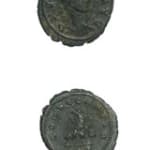Bronze Antoninianus of Emperor Carus Struck Posthumously Under Numerian and Carinus, 283 CE - 285 CE
Bronze
C.4606
Further images
Obverse: DIVO CARO AVG, Radiate and Draped Bust of the Emperor Facing Righ Reverse: CONSECRATIO; An Eagle Standing Facing Forward, Head to the Lef Carus was serving as the Praetorian...
Obverse: DIVO CARO AVG, Radiate and Draped Bust of the Emperor Facing Righ
Reverse: CONSECRATIO; An Eagle Standing Facing Forward, Head to the Lef
Carus was serving as the Praetorian Prefect, when in 282 A.D. he was ordered to prepare the legions in Raetia for a campaign against the Persians. When the soldiers rebelled against Emperor Probus, they elevated Carus to the throne. Enraged, Probus sent a detachment of troops to arrest Carus, however, they deserted to the usurper’s side. A civil war was narrowly averted when a group of soldiers, angry at having been put to work on a domestic vineyard project, murdered Probus. Carus seized the throne uncontested and, unlike his predecessors, did not politely ask the Senate to confirm his elevation; instead he just informed them that he was filling the vacant throne. He instantly conferred the title of Caesar to his two sons, Carinus and Numerian. Later, Carus left his older son, Carinus, in Rome to manage the Western Empire while his younger son, Numerian, accompanied Carus on a campaign against the Sarmatians who were quickly defeated. Having achieved a swift victory, Carus now turned his eyes to the Persians, hoping to undertake the war that had been planned by his predecessors. The Roman army, led by Carus, advanced swiftly through Mesopotamia and then crossed the Tigris River and sacked the Persian capital of Ctesiphon. However, just when a resounding victory seemed in grasp, Carus was killed in a freak storm. Legend has it that a violent storm broke out over the Roman camp and lightning flashes filled sky. After one momentous clap of thunder, the word came out that Carus had been killed by lightning. According to ancient traditions, anyone struck by lightning had invoked the wrath of the gods. Thus, Numerian, who was earlier raised to Augustus along with his brother, ordered the invasion off and the Roman army retreated due to the demands of the superstitious army.
How many hands have touched a coin in your pocket or purse? What eras and lands have the coin traversed on its journey into our possession? As we reach into our pockets to pull out some change, we rarely hesitate to think of who might have touched the coin before us, or where the coin will venture to after it leaves our hands. More than money, coins are a symbol of the state that struck them, of a specific time and location, whether contemporary currencies or artifacts of a long forgotten empire. This stunning hand-struck coin reveals an expertise of craftsmanship and intricate sculptural detail that is often lacking in contemporary machine-made currencies. This ancient coin is a memorial to an emperor’s reign passed from the hands of civilization to civilization, from generation to generation that still appears as vibrant today as the day it was struck.
Reverse: CONSECRATIO; An Eagle Standing Facing Forward, Head to the Lef
Carus was serving as the Praetorian Prefect, when in 282 A.D. he was ordered to prepare the legions in Raetia for a campaign against the Persians. When the soldiers rebelled against Emperor Probus, they elevated Carus to the throne. Enraged, Probus sent a detachment of troops to arrest Carus, however, they deserted to the usurper’s side. A civil war was narrowly averted when a group of soldiers, angry at having been put to work on a domestic vineyard project, murdered Probus. Carus seized the throne uncontested and, unlike his predecessors, did not politely ask the Senate to confirm his elevation; instead he just informed them that he was filling the vacant throne. He instantly conferred the title of Caesar to his two sons, Carinus and Numerian. Later, Carus left his older son, Carinus, in Rome to manage the Western Empire while his younger son, Numerian, accompanied Carus on a campaign against the Sarmatians who were quickly defeated. Having achieved a swift victory, Carus now turned his eyes to the Persians, hoping to undertake the war that had been planned by his predecessors. The Roman army, led by Carus, advanced swiftly through Mesopotamia and then crossed the Tigris River and sacked the Persian capital of Ctesiphon. However, just when a resounding victory seemed in grasp, Carus was killed in a freak storm. Legend has it that a violent storm broke out over the Roman camp and lightning flashes filled sky. After one momentous clap of thunder, the word came out that Carus had been killed by lightning. According to ancient traditions, anyone struck by lightning had invoked the wrath of the gods. Thus, Numerian, who was earlier raised to Augustus along with his brother, ordered the invasion off and the Roman army retreated due to the demands of the superstitious army.
How many hands have touched a coin in your pocket or purse? What eras and lands have the coin traversed on its journey into our possession? As we reach into our pockets to pull out some change, we rarely hesitate to think of who might have touched the coin before us, or where the coin will venture to after it leaves our hands. More than money, coins are a symbol of the state that struck them, of a specific time and location, whether contemporary currencies or artifacts of a long forgotten empire. This stunning hand-struck coin reveals an expertise of craftsmanship and intricate sculptural detail that is often lacking in contemporary machine-made currencies. This ancient coin is a memorial to an emperor’s reign passed from the hands of civilization to civilization, from generation to generation that still appears as vibrant today as the day it was struck.





